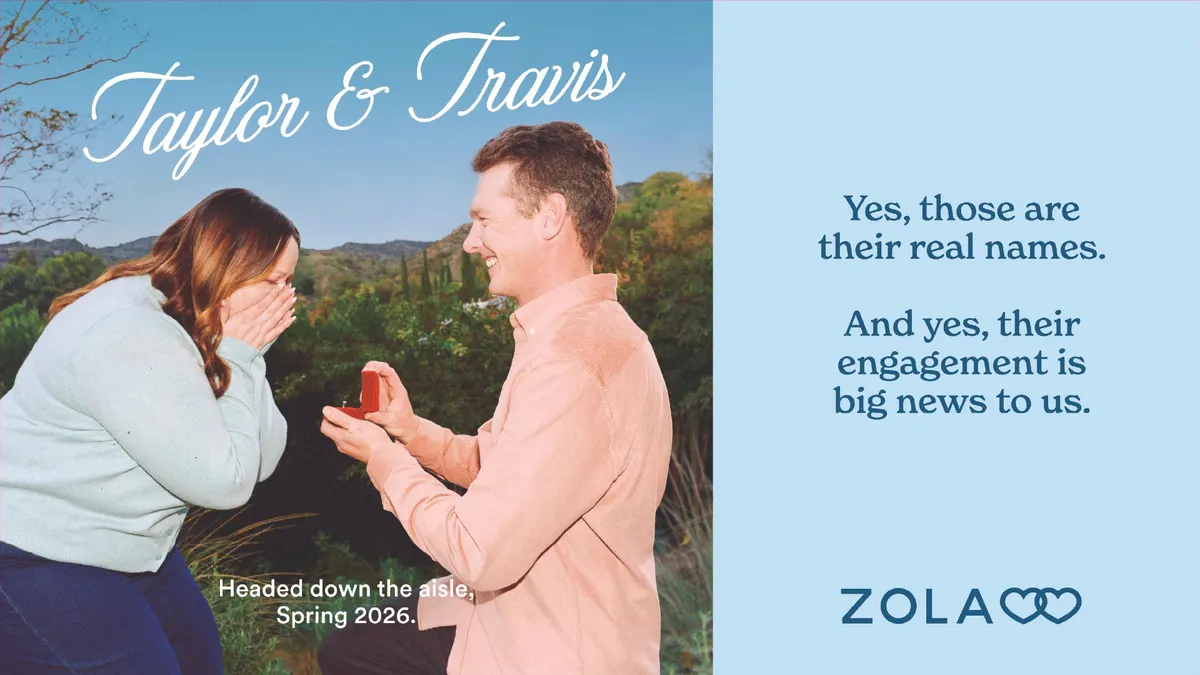Spending on out-of-home (OOH) advertising grew 4.5% in 2018 over 2017, reaching $8 billion, according to Out of Home Advertising Association of America (OAAA). In Q4 alone, spending increased 7.2% year-over-year, the largest quarterly increase since before the Great Recession.
Yet even amid a surge in OOH investments and new digital technology capabilities, attribution remains a major challenge for the channel that encompasses formats like billboards, transit signs and place-based signs. Brands are often unsure how to measure just how many people actually saw an ad and what, if any, impact it had on the viewer.
"Measurement is not a nice-to-have anymore, it's table stakes," Neil Sweeney, CEO of attribution services firm Freckle, said in comments e-mailed to Marketing Dive. "The parallel to this is viewability. At first, it was a nice-to-have, now it's a requirement for any major brand."
Even as it draws parallels with digital marketing — itself going through continued measurement pains — OOH attribution could be a tougher nut to crack, if it's crackable at all.
"You can make a pretty solid argument that OOH is one of the last bastions of marketing where attribution is nearly impossible," Lindsey Boan, director of media at the agency Madwell, told Marketing Dive in an interview. "While some startups claim they can provide reliable modeling for OOH investments, we haven't seen the kind of platforms that would make us feel confident yet.
"We all know that OOH can and does work, but for now we have to be creative, utilizing different variants and proxy KPIs to serve as success metrics," Boan added. "Think promo codes and vanity URLs."
State of OOH attribution
There are some signs of progress. With mobile phones and connected devices on hand for the majority of people that pass by a billboard, it's getting to the point where advertisers can track, in aggregate, who saw what outdoor advertising, and then try to match that to future behaviors. An acceleration toward digital and mobile is reflected in the businesses supporting the OOH renaissance — large tech companies, startups and direct brand disruptors like Amazon, Bumble and Casper.
As brands allocate more budgets to OOH, some of the bigger vendors are rolling out initiatives to meet the measurement demand. Intersection's Place Exchange allows digital event measurement and re-targeting. And Clear Channel offers advertisers the ability to leverage anonymous, aggregated mobile location data to help understand consumer mobility and behavior through its RADAR platform.
In addition, companies are exploring new ways to better understand audiences and foot traffic, seen in partnerships like that between JCDecaux and Neustar.
"As more brands require a direct correlation between OOH spend and consumer action, we'll see more OOH vendors work to develop their own measurement offering," said Brian Rappaport, CEO of Quan Media Group, an OOH planning and buying company, in e-mailed comments. "[U]ltimately the true winners will be those who are able to provide more refined data and analytics helping to further build effective OOH campaigns."
Case in point
What do some of the bids at OOH attribution look like?
Clear Channel can track footfall into specific locations based on opt-in anonymized data that people are using to navigate their lives, which is acquired through services like dating apps and weather apps. It then leverages that data set in the physical world by looking at when a device shows up in a specific location. Using a test control methodology or exposed/unexposed comparisons, a brand can get closer to determining if the campaign worked.
McDonald's worked with Clear Channel on a billboard campaign and then followed up with mobile retargeting to consumers that were exposed to the OOH ads. Consumers exposed to the OOH ads had an 11.12% visit rate to McDonald's locations, and those that saw both the OOH and mobile ads had a 19.81% visit rate.
Brands can use these kinds of behavioral findings to improve future campaigns, Dan Levi, CMO of Clear Channel, told Marketing Dive in an interview.
"We are now able to offer optimization on out-of-home, which is two words I never thought I'd hear used together," Levi said.
Opportunities and challenges with AR
Augmented reality activations built into billboards are one of the latest trends in OOH enabled by mobile — and another potential way to track an outdoor campaign's success.
Burger King, for instance, integrated OOH with mobile AR to let consumers in Brazil get a free Whopper when they pointed an app at McDonald's billboards and virtually burned them down. Puma created an AR experience as part of the launch of its new North American flagship store in New York with interactive signs and shoe tags that activated branded content.
Despite immersive features that make measurement easier, these ad units often have engagement issues. People are usually on-the-go when they encounter such messages. Expecting the consumer to stop and interact is a big ask. Marketers must set realistic goals for these units, which may have a broadcast impact, but won't necessarily achieve high engagement rates unless the reward is very high.
"The tie back to performance and interaction is a nice plus, but how are you going to make that placement stand out in the first place so the consumer takes out their phone and physically interacts with the ad?" said Rappaport. "Ultimately, it ties back to location, and being where the brand truly should be in order to get in front of who they're trying to reach."
Levi said that roadside billboards are not the place for AR, but screens in locations where people gather are ideal.
"It works when people are there more than 10 seconds and the content is static, because you want the content to be the trigger for the interaction," he said. "Think transit walls and screens at events, and places where there is street furniture."
Data obstacles
Beyond AR, companies have rolled out various mobile tech tools to ping phones and collect data such as geographic location, demographic information and store visits. However, marketers still must connect the dots and use third-party data within their own platforms, which can be cumbersome and time consuming.
"We've seen improvement, sure. But we see a majority of it falling into the ability to target verses attribution," said Boan.
"Unless you have big brand first-party data, your campaign is at the mercy of third-party data," Boan added. "Obviously it's better than no data, but it's not the best, or even great, data. Brands and agencies must be cognizant about where the data comes from, how often it's refreshed, and more."
Carefully vetting partners on OOH campaigns then becomes essential. A lot of companies moonlight in measurement but it's not as easy as some think, according to Sweeney.
"Your match table and panel needs to be extensive, which means your engineering expertise also needs to match this," Sweeney said.




















